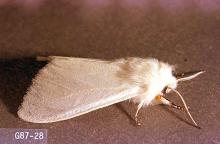Hyphantria cunea
Pest description and crop damage Fall webworm is the most common tent-making caterpillar in North America and has a very wide host range that includes more than 100 deciduous trees and shrubs. Nut trees are among the preferred hosts. The adult moth has a wing expanse of 2 inches and is almost pure white with a few black spots. Larvae are about 1 inch long and very hairy. They have paired dark spots on each body segment. Larvae vary in color, being yellow or pale green with a black head, or a darker color with reddish-brown hairs and a red head.
Biology and life history The insect overwinters as a light-colored cocoon in protected areas like bark furrows or the sides of buildings. Adult moths emerge in late spring, and lay eggs on the undersides of leaves. Larvae skeletonize leaves and incorporate leaves and twigs into their tent. Mature larvae leave the plant and look for a protected place to overwinter. There is usually one generation per year, though in warm areas there may be more.
Management-cultural control
Cut out and destroy any developing tents.
Management-chemical control: HOME USE
- azadirachtin (neem oil)-Some formulations are OMRI-listed for organic use.
- Bacillus thuriniensis var. kurstaki-Treat when larvae first appear. Use a spreader-sticker. Some formulations are OMRI-listed for organic use.
Management-chemical control: COMMERCIAL USE
- Bacillus thuringiensis var. kurstaki-See label for rates. Treat when larvae first appear. Use a spreader-sticker. Some formulations are OMRI-listed for organic use.





